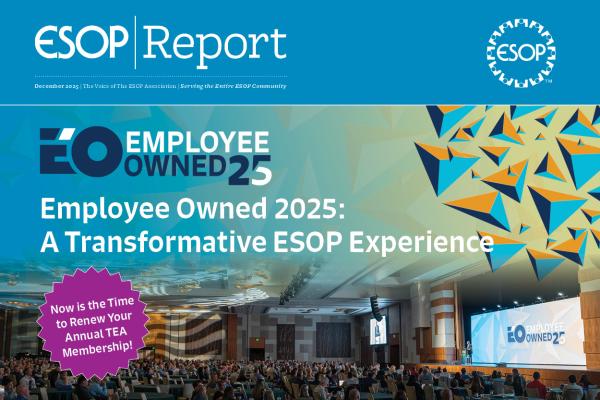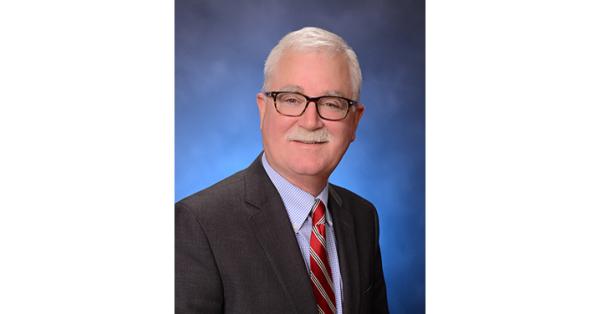- A basic guide summarizing the unique benefits Employee Stock Ownership Plans offer to owners, employees, and communities. This ESOP Brief is available to the public as an informational resource.
An Employee Stock Ownership Plan (ESOP) is a tax- qualified retirement plan authorized and encouraged by federal tax and pension laws. Unlike most retirement plans, ESOPs:
- Are required by law to invest primarily in the shares of stock of the sponsoring employer.
- Are trusts that hold shares of the business for employees, making them beneficial owners of the company that employs them.
- Can provide tax benefits to the company and to the exiting owner(s).
- Can borrow money from related parties to finance company projects—including the tax-advantaged purchase of the company’s shares of stock.
Succession Planning Options
The most common reason for establishing an ESOP is to buy stock from the owners of a closely held company.
Many closely held companies have little or no succession plan in place. As a result, the day a founder or primary shareholder leaves the business often results in significant adverse consequences for the company, the employees, and the exiting owner.
ESOPs offer transitional flexibility that can facilitate succession planning. Founders and main shareholders can sell to ESOPs all of their shares at one time, or percentages of their shares on the schedule of their choosing. The transition in leadership, therefore, can occur as quickly or slowly as the owner wishes.
Providing a Buyer
Finding a buyer for a closely-held company is not always easy, even if the company is profitable. If a buyer cannot be found, businesses may simply shutter, denying the local economy of jobs and the products or services the company provided.
In areas as diverse as rural North Carolina and New York City, ESOPs have been recognized as a way of keeping
businesses locally owned and afloat when buyers are scarce.
Even when buyers can be found, they sometimes layoff part or all of the staff or move the company’s business operations—again, resulting in lost jobs for the community.
By contrast, an ESOP:
- Helps keep the business—and its jobs—in the community.
- Helps provide job security for employees. (The latest national research on the subject shows that companies with employee stock ownership are 7.3 times less likely to lay off employees than conventionally owned firms.)
- Provides a fair value market for the selling shareholder of a closely held company.
- Provides continuity for customers, who continue to interact with the same individuals they always have
- Provides business continuity. Employees, who know the business best, stay in place to continue its operation.
Tax Benefits for Owners
Under federal tax law, owners of closely held companies can defer and possibly avoid tax on the gains made when selling stock to an ESOP—when the following conditions are met:
- The ESOP company is a C corporation at the time of the sale.
- The ESOP owns at least 30 percent of the company immediately after the sale. (The sale of stock by two or more shareholders counts toward this 30 percent requirement).
- The sale proceeds are re-invested in U.S. domestic corporation stocks and bonds within a set time period. To qualify, reinvestments must be made within a
15-month window that starts three months before the date of sale and ends 12 months after the date of the sale to the ESOP.
This “tax free rollover”—which is included in the federal tax laws to encourage the establishment of ESOPs—can be very attractive to retiring owners and shareholders of closely held companies. (For more information, see ESOP Brief #4, The ESOP Tax-Free Rollover.)
Tax and Financing Benefits for Companies
S corporations that sponsor an ESOP are eligible for a different tax incentive: The portion of the business owned by the ESOP trust is exempt from federal (and often state) income tax.
If 60 percent of an S corporation is owned by the ESOP, the business would avoid taxes on 60 percent of its income. A 100 percent ESOP-owned S corporation operates essentially free of income tax. (For more information, see ESOP Brief # 13, ESOPs and S Corporations.)
ESOPs as a Financing Technique
Companies have used ESOPs as a way to finance a variety of efforts, including business expansion, management buy- out, acquiring a target company, spinning off a division, and taking a company private.
In limited circumstances, ESOPs have been used to finance the buy-out of a firm or company division that otherwise would have closed.
The Uses of a Leveraged ESOP
In a leveraged ESOP, the ESOP or its corporate sponsor borrows money from a bank or other qualified lender, and uses the loan proceeds to buy shares from current owners or the company.
If the ESOP is the borrower, the company guarantees the loan. As part of the guarantee, the company agrees that it will make contributions to the ESOP that will enable the ESOP to pay back the loan on schedule.
If the borrower is the company—which is the arrangement preferred by many lenders—the company lends the funds from the loan to the ESOP so the ESOP can buy the shares. (For more information, see ESOP Brief #5, ESOP Financing.)
If the leveraging is meant to provide new capital for company expansion or improvements, the ESOP will use the cash to buy newly issued shares of stock from the company. If the leveraging is used to buy shares of stock from a shareholder, the ESOP generally will acquire those existing shares directly. If the leveraging is being used to divest a division of the company, the ESOP will buy the shares of a newly created shell company, which in turn will purchase the division and its assets.
Two tax incentives make leveraged ESOP financing very attractive.
First, contributions to an ESOP are tax deductible so that:
- The company makes contributions to its ESOP.
- The ESOP in turn pays those contribution dollars back to the company to pay down its loan from the company.
- The company then uses those contribution dollars to pay down its loan from the bank or other lender.
In effect, the company gets to fully deduct the loan’s principal and interest (not just the interest, as is the case for non-ESOP loans). By reducing the number of post-tax dollars needed to repay the loan principal, a company’s cost of financing can be cut significantly.
Second, dividends paid on shares of a C corporation held in an ESOP are tax deductible if they are used in any of the following ways:
- To repay the ESOP loan.
- Passed through to employees.
- Reinvested by employees for more company stock.
This provision of the federal tax law well may increase the amount of cash available to a company, compared to one utilizing conventional financing.
Unique Retirement Plan
ESOPs are a unique retirement benefit. Unlike 401(k)s, most ESOPs require no out-of-pocket contribution from employees. For those employees who feel hard pressed to make an out-of-pocket contribution to a 401(k), an ESOP might be the only plan in which they can afford to participate.
A recent Pew study found that less than half of all non- government employees participate in a retirement plan at work. And 35 percent of private sector employees are not even offered an employer-sponsored retirement plan.
By contrast, many ESOP companies provide their employees multiple retirement plans. Among ESOP Association members responding to a 2015 survey, 93.6 percent offer both an ESOP and a 401(k).
Employee Ownership Incentive
In addition to the financial and tax incentives, most companies establishing an ESOP have a keen desire to provide an employee ownership incentive and benefit. In fact, for some companies, the ownership and benefit incentive is the primary reason for the ESOP.
Research has shown that giving workers a significant stake in the company that employs them improves employee attitudes toward the company, and these improved attitudes translate into improvement of the company’s bottom line.
Companies may well find the added productivity resulting from employee ownership in the company makes the ESOP the best choice. (For more information, see ESOP Brief #6, The Benefits of Employee Ownership.)
An ESOP Is a Trust
An ESOP is established by the company adopting specially designed ESOP plan and trust documents.
The ESOP plan provides to each participating employee an individual account where benefits accrue over the years. The ESOP trust holds the shares of company stock and company contributions made to the ESOP. These contributions and shares of stock are credited to the individual participants’ accounts.
Different formulas may be used for allocations to these accounts. These allocation formulas may be based on years of service, compensation and years of service, or equally (per capita).
The most common formula provides allocations in proportion to each participant’s annual “W-2” compensation for the year.
Typically, employees start participating in an ESOP and begin receiving allocations after completing one year of service with the company. A year of service is most commonly defined as any 12-month plan year period in which an employee is credited with at least 1,000 paid hours.
Vesting
The shares of company stock and other plan assets allocated to participants’ accounts under the ESOP must be subject to a vesting schedule in which each participant has a right to an increasing percentage of the ESOP account over time. The two basic vesting schedules allowed by law are:
- Six-year graded vesting, with 20 percent vesting per year starting after two years of service and resulting in 100 percent vesting after six years.
- Three-year cliff vesting, with no vesting before three years of service and 100 percent vesting after three years.
These vesting schedule requirements are identical to the ones applied to 401(k)s. An ESOP may have a more rapid vesting schedule, if desired.
Diversification
Participants in privately (closely) held company ESOPs who are 55 or older and have participated in the plan for at least 10 years are legally required to have the option of
diversifying up to 25 percent of their ESOP account credited with company shares. This investment diversification option continues for five years (typically to age 60), at which time the participant must have the option of diversifying up to
50 percent of his or her company shares account. (For more information on diversification, see ESOP Brief #12, ESOP Diversification.)
Payouts
ESOP participants must receive the vested portion of their ESOP accounts after retirement, death, or other termination.
For retirement or death, payment of the vested ESOP benefit generally starts in the following year. For termination benefits, the start of payments may be delayed for up to five years after the year of termination.
ESOP benefits—whether due to retirement, death or other termination—can be paid in substantially equal installments over five years. Other options are allowed by plan design, including lump sum payments.
The benefit payments may be in the form of company stock and/or cash. In some situations, company stock is required to be offered; in others, it is never offered.
If the ESOP benefit is paid in the form of company shares and the company is closely held (non-public), the
participant (or beneficiary) must have a put option right that requires the company to buy back the distributed shares at the ESOP set price.
The put option right has two 60-day periods. The first begins after the distribution is first made; the second (which applies if not put and sold in the first period) is set in the next plan year after the first 60-day period.
No other put option periods are required, and the company has no other obligation to repurchase such shares.
If an S corporation ESOP distributes shares, the put option/company purchase generally is mandatory. (For more information on distributions, see ESOP Brief #18, ESOP Distributions.)
Additional Resources
This brief is the first in a series that is organized into two broad categories. The first is well suited to those considering an ESOP or for sharing with employee owners at an existing ESOP company. The second is best suited to executives and trustees who want a more technical overview of the issues involved in managing an ESOP.
We also recommend our booklet, How The ESOP Really Works, which provides an overview of the legal and business mechanics of ESOPs. For information on these publications, visit the ESOP Association Website or contact their Membership Department at membership@esopassociation.org.







